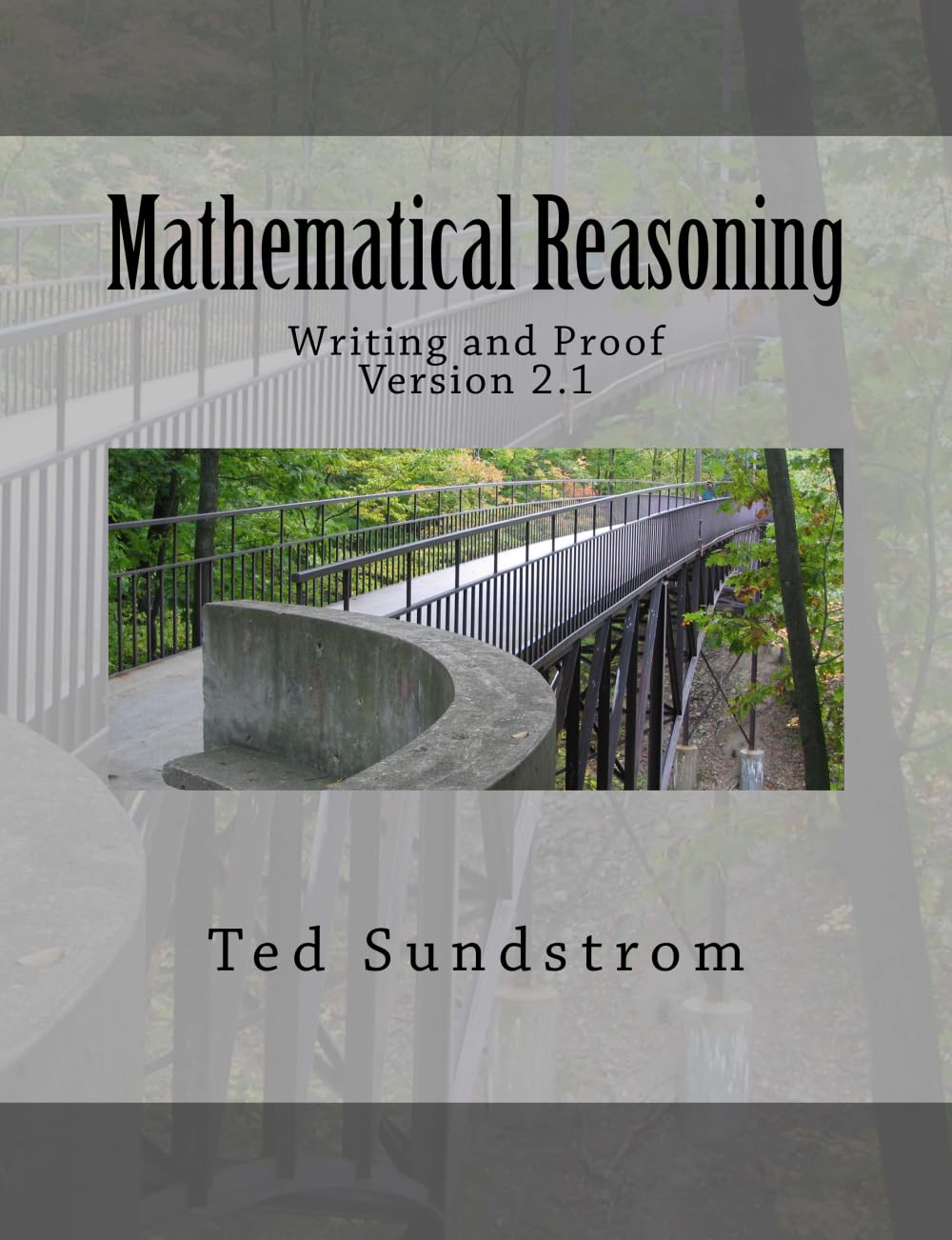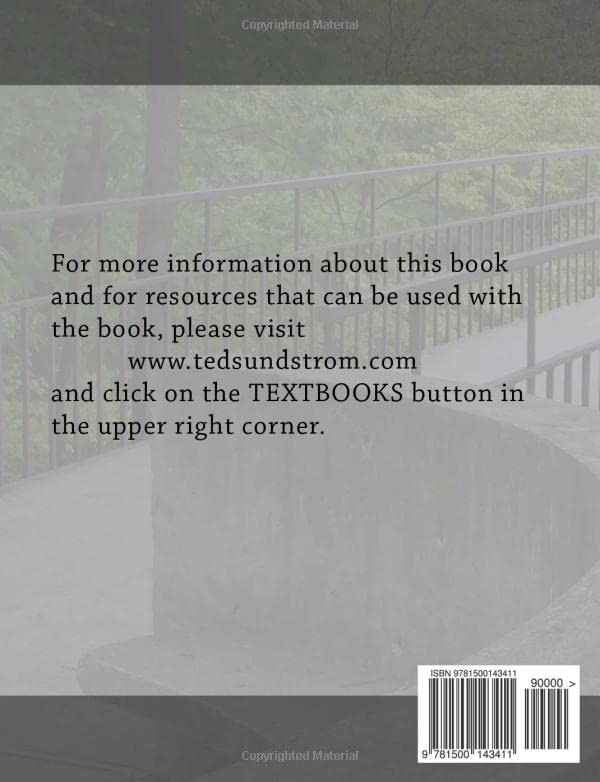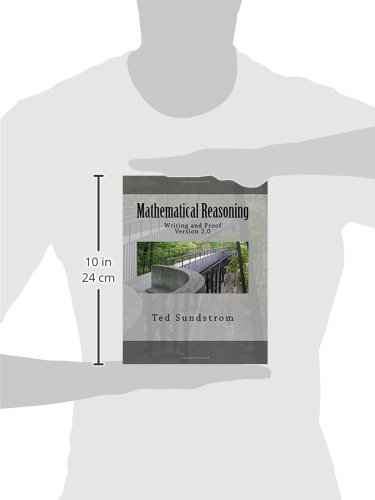



Full description not available
W**R
Great textbook on Writing and Proofs for Undergraduate Mathematics students.
The 'know-show table' technique for the draft version of a proof is very useful before writing a formal proof that follows the guidlines of mathematical proofwriting.To solve a math problem I would use the steps:1. Problem solving with 2 subfases:1.1 Analyze ( understand the problem and more general). With more general: resolving problems by methods which, at first sight, seem to have nothing to do with the problem at hand for example change the problem.1.2 Plan without guidelines of proof writing (proof strategy/draft version of the proof).2. Argumentation:2.1 Synthesis: summary/expert proof/the condensed form of the analysis and the plan of problem solving/polished solution.2.2 Plan with guidelines of proof writing.3. Reflection (optional): Reflection is the abstraction of problem solving and argumentation.3.1 Generalize the problem and solve this problem.3.2 Make an alternative solution.The details of the analysis of the problem, the intermediate steps of calculations, a similar case of the proof technique case analysis, a similar direction of 'if and only if', the details of mathematical induction and other things are omitted in a formal proof. The most extreme form of condensed proof is an expert proof. The details of a proof must be filled in by the reader. Carl Friedrich Gauss used the principle of condensation in clean math proofs. Gauss writing style was terse, polished, and devoid of motivation. Abel said: `He is like the fox, who effaces his tracks in the sand with his tail'. Gauss:`no self-respecting architect leaves the scaffolding in place after completing the building'. A mathematical proof is similar to the summary of a literary genre such as the summary of the fairy tale "Alice in Wonderland" on the back of the book. The details of problem solving are omitted (abstraction) in a clean math proof because abstraction is important in pure mathematics and the proof is dense full of mathematical proza. The structure of a clean math proof is always linear: from the hypothesis P to the conclusion Q (one of the guidelines of proof writing). The plan in problem solving is a detailed plan without guidelines of proof writing and is a possible solution. The argument is an abstracted plan with guidelines of proof writing. With the application of the rule of synthesis (polished solution). You see symmetry when you compare problem solving and argumentation in mathematics: analysis in problem solving is the opposite of synthesis in argumentation. A plan without guidelines in problem solving is the opposite of a plan with guidelines in the argumentation.A technique of the plan that cannot solve the mathematical problem is still a technique of analyzing. Hence the division of analyzing and making a plan can be a blurred. When the solution is found, it's clear which techniques have been used for analyzing and which techniques have been applied for creating a plan. After the solution is found, it's clear which technique of the plan is a strategy or a tactic.The suggestion to solve mathematical problems of math olympiads to learn problem solving in math is useless. You must first learn the fundamentals of proof techniques, follow the guidelines of rigourous proof writing and learn commonly used techniques of problem-solving among mathematicians (techniques in this book). The next step is solving mathematical problems.The most important technique for a problem solver is: make examples or find a counterexample. You create MANY examples for insight in the abstraction or for a hint for proof writing. You can't use examples for a proof but: Examples give a hint to use a existing mathematical fact in a proof. Abstract the concrete hint and use the abstract hint as fact in a proof. Applied math is pure calculation. Pure math contains abstract concepts you must perform with little to no calculations. Or where you will not be able to solve the problem with just calculation. An example of solving an abstract concept is to prove a statement of set theory. Creating examples or a counterexample is the most important technique for the problem solver and it's the basis for mathematical explorations in pure mathematics.
N**I
Great book for introducing abstract math concepts
This is the BEST undergraduate math book I have used because it serves as a bridge between the lower division mathematics (ie computational math) and upper division mathematics (ie the more abstract concepts). This book provides preview activities to introduce one to a particular concept, progress checks to see if one is understanding the concept thus far, chapter summaries and answers to selected exercises (usually the starred exercises)Chapters include:1 Introduction to Writing Proofs in Mathematics2 Logical Reasoning3 Constructing and Writing Proofs in Mathematics4 Mathematical Induction5 Set Theory6 Functions7 Equivalence Relations8 Topics in Number Theory9 Finite and Infinite Sets
P**E
Authentic and empathic
Wow, that's one book that really took the responsibility of teaching seriously to it's reader instead of sounding all important. I'm still working on the chapters but I had so far found no problem understanding the language or any obscurity at all. Thank you Mr. Ted. I hope you write more books.
K**T
Content is great and there is great instruction and explanation
This is our text for an intro to proofs class. The cheapest college textbook you'll find! Finally someone trying to make material available to students at a reasonable price. Content is great and there is great instruction and explanation. I'm very happy with it.
R**S
A solid choice
This is a very nice introduction to the notion of proof and rigor in mathematics. A real value as well.
K**N
Wonderful cheap book
Wonderful cheap book, that was nice to order and get. Despite it being a open resource textbook, it was nice to pay very little for a already printed and bound version of the book.
E**Y
Good information, poor construction
This book was required for one of my math classes. There is a newer version of this book available as a free pdf but I like to have an actual book. The binding of this book is a little cheap and as such the book is already showing signs of heavy use. A hardback would have been nice.
A**A
Nice.
This book is an easy read. And it is well made. I'm glad I was assigned this book for my class.
Trustpilot
3 weeks ago
2 weeks ago